Dogs can be allergic to cats, mainly because of proteins in cat dander, urine, and saliva. When a dog’s body reacts to these proteins, it releases histamine. This leads to various symptoms.
It’s not very common, but about 1 in 20 dogs show a strong reaction to cat dander in allergy tests.
Genetics play a big role in allergies, but being exposed to allergens like cat dander might help prevent them in some dogs. This shows how important it is to understand the mix of genetics and environment in pet health, even in homes with multiple pets.
Understanding Dog Allergies to Cats: Basic Facts
Dog allergies to cats work like other environmental allergies. They are caused by proteins in cat dander, urine, and saliva. While there’s no cure, there are ways to manage it. Allergen-specific immunotherapy, or “allergy drops,” can help dogs build up a tolerance. This treatment works for about 70% of dogs with allergies.
The process of getting used to these allergies can take 6-12 months. It’s a gradual process.
Pet allergies can start with exposure to dead skin flakes (dander) from pets. Allergens are in skin cells, saliva, urine, and sweat. These allergens can stay in the air for a long time.
Preventive steps can lower the risk of serious issues like sinus infections and asthma attacks. These problems can come from pet allergies.
“Some dogs are more prone to shedding than others, potentially spreading allergens to other pets in the house, including cats. Investing in the best dog food for shedding can help reduce the likelihood of cats developing allergies.”
Keeping things clean is key when dealing with pet allergies. This includes vacuuming carpets, washing bedding often, and using air purifiers. These tools help get rid of pet dander.
Medicines like antihistamines, steroids, or allergy shots might be needed. A vet will guide you on how to use them for your cat’s allergies.

Getting an allergy test is important to find out what’s causing your cat’s allergies. This helps in making a treatment plan that works better. If your cat’s allergies are severe, you might need to see a vet specialist. They can help create a detailed plan for treatment.
Can Dogs Be Allergic to Cats: Signs and Symptoms
Dogs can get allergic to cats just like humans do. These allergies can show up in different ways, affecting a dog’s health. Knowing the signs of cat allergies in dogs is key for pet owners to help their pets.
Physical Symptoms
One big sign of a dog being allergic to cats is excessive itching. Dogs often get itchy skin on their paws and belly. This is because these areas are more exposed to cat allergens.
Other signs include red or inflamed skin, hair loss, sneezing, coughing, and a runny nose. These pet health symptoms mean a dog might be allergic to cats.
Behavioral Changes
Behavioral changes can also hint at a cat allergy in dogs. Dogs might scratch, lick, or chew their skin a lot. This can make their skin even more irritated, leading to pustules or crusts.
Some dogs might also wheeze, showing signs of respiratory issues. But skin problems are more common.
Spotting these pet health symptoms early is vital. It helps keep dogs safe from are cloves toxic to cats and ensures they stay healthy. Working with a vet is the best way to manage these allergies and help your dog feel better.
“Allergies in dogs can have a significant impact on their quality of life, and it’s important for pet owners to be aware of the are cloves toxic to cats and other environmental factors.”
Genetic and Environmental Factors
Dogs can develop allergies due to their genes. Some breeds, like Pugs and Poodles, are more likely to have allergies. This includes sensitivities to cats. Dogs with health issues like atopy or food allergies are also at higher risk.
Age is another factor. Allergies often get worse as dogs get older. Being around cat dander can also cause allergic reactions in some dogs. Studies have shown that pets can influence the development of allergic sensitization and allergic diseases like asthma and allergic rhinitis.
“Multiple factors contribute to inconsistencies in study results related to pet exposure and atopy,” explains a leading researcher. “High-dose exposure to cat allergen can cause a non-allergic immune response. Endotoxin can affect the balance of Th1 and Th2 responses.”
Also, living in areas with many cat and dog owners can increase pet allergen levels. The protective effect of owning both cats and dogs was observed in subjects who had both types of animals at home.
In conclusion, genetics and environment both play a part in dog allergies to cats. More research is needed to understand this complex issue. This will help pet owners and their pets live healthier lives.
Diagnosis and Testing Methods
Finding out what makes your dog allergic is key to helping them feel better. Whether it’s eo for cats or something else, vets use many tools to figure it out. They do physical checks and special tests to find the problem.
Professional Diagnosis
The radioallergosorbent test (RAST) is a common allergy test for dogs. It uses a blood sample to find out what allergens your dog reacts to. Intradermal allergy testing (IDAT) involves injecting small amounts of possible allergens under the skin to see if there’s a reaction.
These tests help vets understand what your dog is allergic to. They then create a care plan just for your dog to manage their allergies.
At-Home Observation
You can also help figure out what’s causing your dog’s allergies by watching them at home. Look for signs like a lot of scratching, red or watery eyes, sneezing, coughing, or tummy troubles. If your dog keeps getting ear infections, it might be an allergy sign too.
By watching your dog closely, you can give your vet important info. This helps them make a correct diagnosis and the best treatment plan for your dog.
“Accurate diagnosis is key to managing pet allergies effectively and improving the quality of life for both you and your furry companion.”
If you think your dog has allergies, getting veterinary care is a must. With the right help, your dog can feel better and live a happier, healthier life.

Treatment Options and Management Strategies
If your dog is allergic to cats, there are several treatment options and management strategies to consider. Allergen-specific immunotherapy, such as allergy shots or sublingual (under-the-tongue) drops, can help desensitize your dog’s immune system over time. Oral allergy medications like antihistamines or Apoquel can also provide relief by reducing inflammation and controlling symptoms.
Strengthening your dog’s skin barrier through a diet rich in essential fatty acids and supplements can help minimize pet allergy management. Regular bathing with specialized shampoos and wiping your dog with a damp cloth after exposure to cat dander can also be effective in reducing allergens. Maintaining a clean home by vacuuming and using HEPA air filters can further minimize your dog’s exposure to essential oils that are harmful to dogs.
If introducing a new pet, consider hypoallergenic cat breeds like Bengals, Russian Blues, or hairless cats, which may produce fewer allergens. In severe cases, limiting interactions between your dog and the cat may be necessary to manage the allergy.
“Proper management of pet allergies is essential for the well-being of both you and your furry companions.”
Remember, early diagnosis and a thorough treatment plan can greatly improve your dog’s quality of life. Work closely with your veterinarian to develop the best approach for managing your dog’s essential oils that are harmful to dogs and pet allergy management.
Conclusion
Dogs can be allergic to cats, but they can live together with the right care. Regular grooming and cleaning help a lot. Also, taking your dog to the vet often is important.
There are many ways to treat dog allergies to cats. Options include shots, medicine, and cleaning the environment. Working with a vet helps find the best treatment for your dog.
Early action is key to keeping pets healthy in homes with many animals. With the right steps, dogs and cats can get along well. By focusing on managing allergies, pets can be happy and healthy together.
Remember, early detection and proactive management are key to maintaining the optimal pet health care in multi-pet households. With the right steps and a vigilant approach, dogs and cats can live together harmoniously, with minimal interference from allergic reactions. By prioritizing allergic reactions management, pet owners can ensure the happiness and comfort of all their beloved animal friends.



